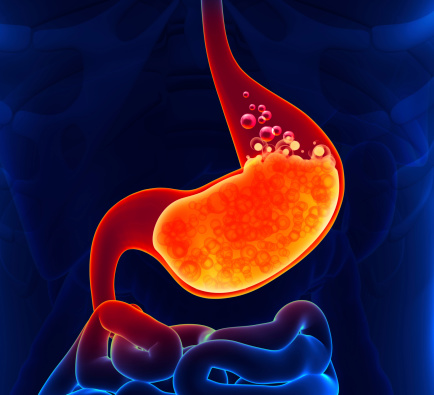Special foods designed for patients with rare inborn errors of metabolism (IEMs) may cause harm when their use is not monitored and managed, according to a research team led by scientists at the National Human Genome Research Institute (NHGRI), part of the National Institutes of Health.
The conclusions are based on more than 10 years of observational studies with large patient groups involving two inborn errors of metabolism. The two IEMs studied are rare genetic disorders in which the body cannot properly turn food into energy. The studies appeared online on August 13 and in the August issue of Genetics in Medicine.
In one of them—isolated methylmalonic acidemia (MMA), mutations in any one of four genes can impede enzyme activity that is necessary for the proper breakdown of amino acids, the building blocks of proteins (specifically the amino acids valine, isoleucine, methionine and threonine). In the other, cobalamin C (cblC) type combined MMA and hyper-homocysteinemia, failure to properly process vitamin B12 results in a different form of MMA that clinically looks different and requires different management.
The MMA study was led by Irini Manoli, M.D., Ph.D., a clinical and biochemical geneticist in NHGRI’s Organic Acid Research Section. Other co-authors included Jennifer Myles, M.S., R.D., of the NIH Nutrition Department; Jennifer Sloan, Ph.D., M.S., and Dr. Venditti, of NHGRI; and Oleg Shchelochkov, M.D., of the University of Iowa Hospitals and Clinics.
61 patients enrolled from metabolic treatment centers across the United States and abroad were evaluated at the NIH Clinical Center between 2004 and 2014. Most of the patients received part or all of their nutrition from a special mix of natural protein and MMA medical foods delivered through feeding tubes. Analyzing the patients’ dietary records and lab results, the NHGRI researchers found that when patients on restricted protein diets were given medical foods used to manage MMA, especially in large amounts, the relationships between certain essential amino acids were disturbed. Further observational studies led by Dr. Manoli, and conducted with a treatment team from the University of Iowa in Iowa City, showed that reducing the intake of medical foods resolved amino acid deficiencies without having to increase the protein intake.
Medical foods for MMA do not contain intact protein. They contain free amino acids with the exception of the four “toxic” amino acids that MMA patients cannot metabolize. These amino acids are essential; the body cannot make them, but people must consume a certain amount to support body and brain growth and function.
In patients with MMA, growth outcomes were poor. In most patients, height, weight and head circumference were lower than average, while body mass index (BMI) and body fat percentage were higher. In particular, the patients ended up with four or five times the recommended amounts of leucine, which, when in excess, causes a depletion of the other branched chain amino acids, valine and isoleucine.
The researchers say to prove a cause-and-effect relationship between the amino acid deficiencies and the poor growth outcomes observed in the patient group a large prospective clinical trial will be needed.
In the second, the cobalamin C (cblC) deficiency study, the researchers concluded that cblC patients should never be given current-day medical foods designed for patients with isolated MMA. They say these patients have high levels of methymalonic acid and homocysteine in their blood and urine and cannot adequately synthesize the amino acid methionine. As this reaction depends on vitamin B12, cbIc patients require intramuscular vitamin B12 injections and betaine.
Authors of the cblC study were: Drs. Venditti, Manoli and Sloan; Ms. Myles; Nuria Carrillo-Carrasco, M.D., of NIH’s National Center for Advancing Translational Sciences; Eva Morava, M.D., Ph.D., of Tulane University Medical School in New Orleans; and Drs. Strauss and Morton. The late Harvey S. Mudd, M.D., a physician and NIH researcher in metabolic disorders, was also instrumental in this work.
Researchers say foods designed for patients with isolated MMA don’t have methionine and are restricting the exact amino acid that needs to be increased in cblC patients. In addition, these medical foods’ relatively high leucine content may block methionine and other amino acid transport into the brain, where they are needed for growth. The authors worked in collaboration with Kevin Strauss, M.D., and Holmes Morton, M.D., of the Clinic for Special Children in Strasburg, Pennsylvania, to help model brain uptake of amino acids to support their observations.
The NHGRI researchers enrolled 28 cblC patient participants in this study, age two to 27. A subset of nine participants received medical foods while another six followed protein-restricted diets. Both groups had lower growth rates, including decreased head circumference, than other patients who were on natural diets that provided the recommended daily allowance of protein. Another case scenario was provided by the treatment team from Tulane University. It showed that increasing natural protein intake and discontinuing methionine-restricted medical foods helped improve head growth and blood amino acid concentrations in an infant with cblC.
“There is no theoretical rationale or experimental support for the practice of administering medical foods to patients with cblC deficiency,” the researchers wrote in their article.







